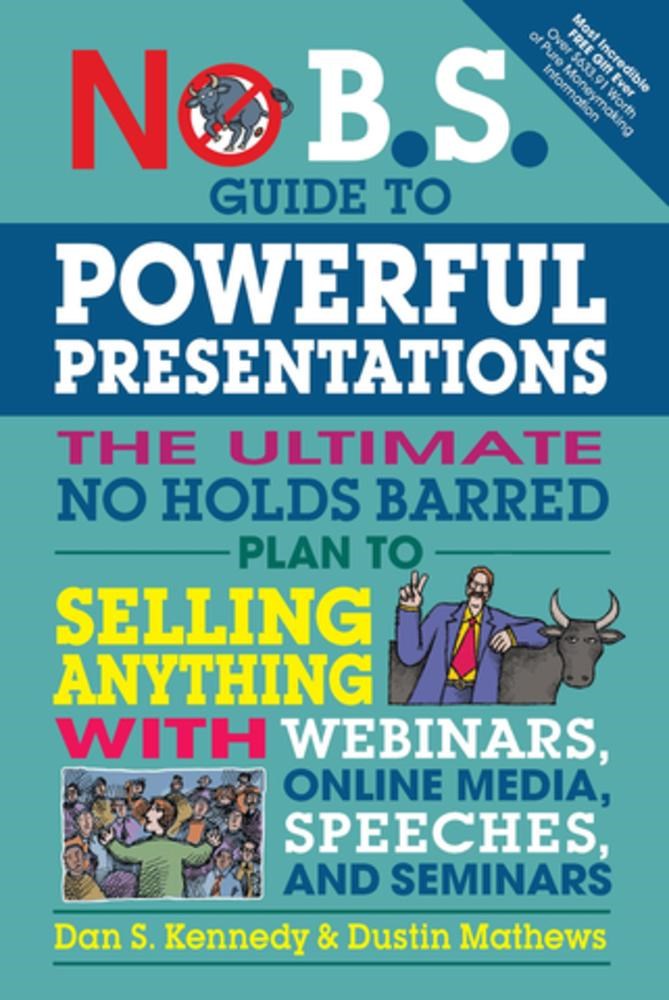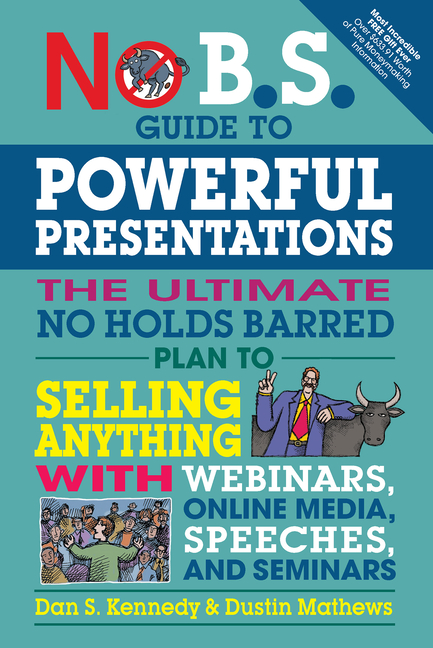No B.S. Guide to Powerful Presentations: The Ultimate No Holds Barred Plan to Sell Anything with Webinars, Online Media, Speeches, and Seminars
June 13, 2017
Dan Kennedy and Dustin Mathews tell us why knowledge of your audience is the first step in creating an effective, powerful presentation.

Knowledge of your audience is the first step in creating an effective, powerful presentation. It is just one of the lessons Dan Kennedy and Dustin Mathews impart in their new book, No B.S. Guide to Powerful Presentations—out today and which, knowing many of our readers are aspiring entrepreneurs and authors, we thought you might be interested in.
In the excerpt below Kennedy and Mathews tell you that, if you can answer these 10 questions about your audience, you're on the right path.
◊◊◊◊◊
10 Magic Questions That Will Tell You Everything About Your Presentation's Target Audience
The first time I peered through a curtain into a basketball arena and saw 15,000 people there, soon to have me come out from behind that curtain, I briefly wondered if I was up to it. I subsequently appeared on that event tour over 230 times in as many as 27 cities a year for nine consecutive years and never felt trepidation about it after those first few minutes. By then, I had—as arrogant as it may sound—mastered two kinds of knowledge-producing know-how that provided more than enough competence for more than enough confidence.
One of those knowledge sets was the architecture for powerful presentations: the script. Its order, its language, its ebb and flow. The best mix of exposition, assertion, story, humor and more.
The other set of knowledge I’d learned to acquire and use was Audience Knowledge.
When a presentation lands a direct hit on an audience’s interests, beliefs, doubts, fears, hopes, ambitions, pre-existing ideas and pre-existing self-talk, its acceptance and enthusiasm for you as the presenter skyrockets and expands, and it’s nearly impossible to fail. In fact, you’re given more credit than your actual performance may deserve. When you know who the people in your audience are, what their lives are all about, what their daily experiences are, what their deepest-seated emotions are, you can make sure the presentation you assemble and deliver lands one direct hit after another after another.
What is a direct hit? It is an idea, assertion, single sentence, or single story that is precisely and exactly in sync with the audience hearing it. As an example, any time I talk to entrepreneurs about being the lone polar bear in a forest of grizzlies, and then talk about their sense of isolation and loneliness, of being underappreciated and disrespected, of being negatively labeled (workaholic, greedy, evil 1%’er, etc.), I land a direct hit.
When I first heard Zig Ziglar talk to “lowly” salespeople about being in “THE Proud Profession,” being the unsung heroes of the entire economy, the engine on which everything and everyone depended, and as improving lives for a living, I recognized he was landing a direct hit. I’ve borrowed that entire idea for my own presentation, books, newsletters and dialogue with salespeople.
My somewhat odd “style” for being on stage and delivering presentations would likely have gotten me a big, red “F” in my college speaking class. But what makes it work, or maybe allows for it to work, is my deep and thorough understanding of my audiences. For 40 years, I’ve gone out of my way to create and deliver presentations to audiences I am certain I have intimate understanding of. I believe I can recite for you, verbatim, the late night, kitchen table conversation that occurs in their homes, when one can’t sleep and comes downstairs and the other notices his or her absence from the marital bed and follows. I believe I can recite for you, verbatim, that person’s major, recurring conversations with himself that he has as he drives his car to and from work.
From about 1979 to 1983, I spoke to a lot of chiropractic and dental groups. Some of these doctors who first saw and heard me then, in small groups of 30 to 100, or on a few occasions at large events of 1,000 to 3,000, are still with me today, as newsletter subscribers and even attending seminars where I speak—34 to 38 years later! It’s important to understand I am not and never was a chiropractor or a dentist, never worked in any capacity in such practices and cannot adjust your back or drill your tooth. But by my presentations to these audiences alone, I have generated at least $20 million in direct revenue, plus countless lifelong customers of considerable value. For these same audiences/markets, I’ve written and developed presentations for 18 different clients who all sell various goods and services, and these, combined, have generated much more revenue. One such presentation is the genesis of a $30-million-per-year business, likely worth at least $150 million if and when it is sold. How is all this possible without having been a DC or DDS?
You don’t have to be one of a particular population in order to develop thorough knowledge about that population: how they think, what they feel and what they truly, deeply want. First of all, a certain amount of human nature, psychology and reactive behavior is either hardwired or deeply embedded in early childhood, by about age 10. This is universal, to all groups, and can be used in embedding “triggers” into presentations that audiences can’t resist responding to.
Second, there are basic questions to ask and know answers to about any target market or audience, for any advertising, marketing, persuasion or influence effort, regardless of how it’s to be done. Here’s this “magic list”:
- What keeps them awake at night, indigestion boiling up their esophagus, eyes open, staring at the ceiling?
- What are they afraid of?
- What are they angry about? Who are they angry at?
- What are their top three daily frustrations?
- What trends are occurring and will occur in their businesses or lives?
- What do they secretly, ardently desire most?
- Is there a built-in bias to the way they make decisions? (Example: engineers = exceptionally analytical)
- Do they have their own language?
- Who else is selling something similar to their product, and how?
- Who else has tried selling them something similar, and how has that effort failed?
Finally, there’s the sense of a group to be gained by reading what they read, hanging out where they hang out, talking, listening or playing anthropologist. For instance, a weekend at a boat show will give you a lot of knowledge about boating enthusiasts. From all three things comes Audience Knowledge, and with Audience Knowledge as the foundation of your presentation, you cannot fail.
Excerpted from No BS Guide to Powerful Presentations
by Dan S. Kennedy and Dustin Mathews.
Copyright © by Entrepreneur Media, Inc.
All rights reserved.
ABOUT THE AUTHORS
Dan S. Kennedy is a multi-millionaire serial entrepreneur with past and present interests in diverse businesses; a strategic advisor, marketing consultant and coach with a cadre of private clients ranging from exceptionally ambitious entrepreneurs to the CEO’s of companies as large as $1.5 billion; one of the highest paid direct-response copywriters in the world; a popular professional speaker and seminar leader; and a prolific author. He lives in Phoenix, AZ.
Dustin Mathews is a direct response marketer known for his unique ability to transform businesses and brands. He runs Speaking Empire, a disruptive company in the leadership training and education space.


